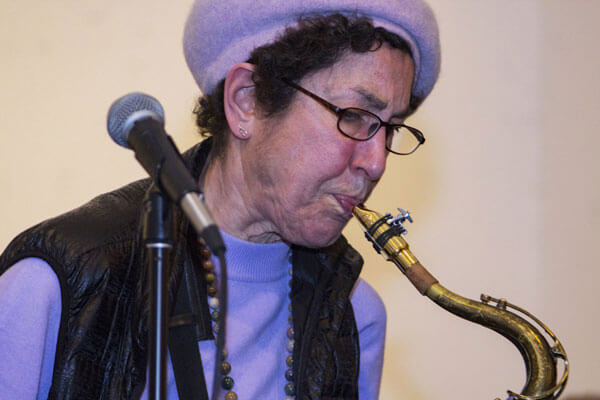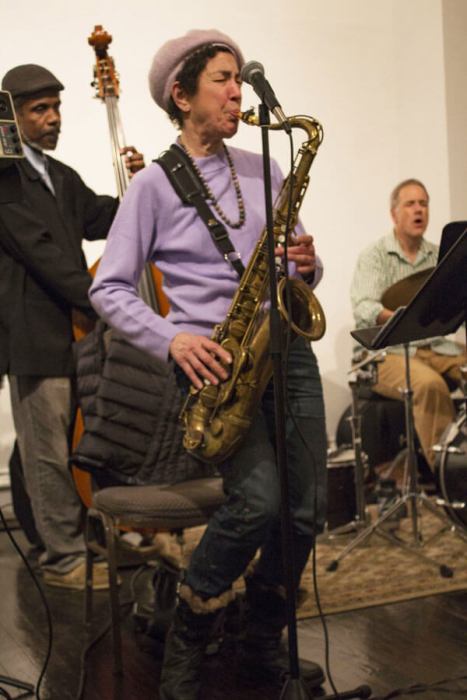By Naeisha Rose
Finding one’s calling in life is never easy, and for jazz saxophonist, pianist, flutist, and clarinet player Carol Sudhalter, that proved to be an exceptionally rocky path, despite growing up in a family of jazz musicians.
“It’s a funny thing. I didn’t even think that I would be a jazz musician,” said Sudhalter. “I grew up on jazz. I loved it. I followed bands around … [but] I was a biology major in college. Then all of a sudden, in the summer before my last year, I started therapy because I was in a depression. After therapy, I realized I didn’t want to be a biologist.”
Even though she still loved biology, Sudhalter knew that she had to pick up an instrument.
“I think I knew already that I could hear jazz ideas in my head, and it was just freeing up my personality that made me feel like it was my time to play something instead of just following bands around, listening them and dating guys that were musicians,” said Sudhalter.
She decided at first to study classical flute, however, because she worried it would be difficult for her to pursue jazz and also be her own woman.
“All of the jazz musicians in my family, they were men. I didn’t feel as a woman anxious to walk in their shadow,” said Sudhalter.
Her father Albert was a jazz saxophonist in her native Boston. Her brothers Richard and James were trumpet and saxophone musicians, respectively. Her uncle Arnold Kirsch played tenor sax.
“I didn’t think that women could be jazz musicians,” she said. “That thought never came into my mind, even to picture myself as a professional jazz musician.”
But her teachers quickly saw that Sudhalter’s gift was for jazz.
“They said not everybody could improvise like this,” she recalled. “This is a special ability.”
And about a year after graduating from Smith College in 1964, Sudhalter had an experience that opened her eyes to her potential as a jazz musician.
“Suddenly, I went out and heard Lisa Brown. She was a sax player in Boston at that time,” Sudhalter said. “When I heard her playing in a band — boom — right away I went out for a job in a band.”
In the 1970s she took two improvisational courses at the New England Conservatory with jazz trombonist Phil Wilson, and later studied under jazz pianist Ran Blake. It was from Blake that she learned the Third Stream style, which combines classical and jazz.
“Blake taught us to draw from all styles of music,” said Sudhalter. “He taught us to listen to everything and draw on every style.”
But it was Queens musician George Walker “Big Nick” Nicholas who introduced her to the sax.
“He taught me similarly to listen to everything. He had me memorizing lyrics to songs and reading passages of Jessye Norman, the great opera singer. He really opened my mind to how many influences there are to us.”
Sudhalter said singers such as Billie Holiday, Frank Sinatra and Louis Armstrong were a big influence on her as well, as her mentor challenged her to translate their vocal through her own instrument.
“I think the interesting thing about vocalists is the learning how to take the words and then trying to learn how to put those words through your horn. Big Nick would have me play thinking about the words,” she said. “That’s one of the things that people can hear in my music.”
Even though she learned from the greats, and had started becoming a formidable jazz saxophonist in her own right, the men in her life were not supportive of her career choice.
“It seemed it was taboo. I had even repressed the thought. That’s how it was in those days” she said. “One of my oldest friends who plays the trumpet started saying to me, ‘You should really examine your motives for why you want to go into jazz, this isn’t appropriate for a woman.’”
But years later, after she had distinguished herself as a musician, that friend, Stan Shafrin, finally changed his tune.
“After I came to New York [in 1978], he was like, ‘Carol I want to make you the lead alto in this band,’” said Sudhalter.
Shafrin and Sudhalter were able to make amends before his death, but the sting of the words remained.
“Boy, I thought it was ridiculous. I mean, that was one of many comments, but that was one of the most outstanding that I remember,” she said. “I just knew it was wrong and that it didn’t make sense.”
The hurt that Sudhalter felt from Shafrin’s comments, however, paled in comparison to her father’s disappointment.
“He was really upset. He saved all his life for this really expensive women’s college so that I could get a really fancy job or get married to a status person — this traditional path,” she recalled. “The last thing he wanted to see me in was in jazz music. He wouldn’t even come to my concerts.”
In 1975, a decade into her career, Sudhalter’s father finally came to a performance — just four months before he passed away.
“I was having a concert at the conservatory in Boston and we had an argument. He said he wasn’t going to come because he couldn’t find parking, but he showed up. He had tears in his eyes and he was really moved. It was fabulous,” she said. “Some people fight for acceptance from their parents and they never get it. It was a blessing.”
Sudhalter attributed her father’s wariness of her joining the business to the treatment of women he saw during his time as a jazz musician.
“He saw the hard knocks, the sexist things that were happening,” she said. “He didn’t want me to be a part of that world because he thought it wasn’t very nice.”
At this point in her career, Sudhalter is happy to see how far jazz music has come in including women.
“There have always been great [female] jazz pianists and singers, and they were accepted. But [women who played] trumpets, saxophones, and trombones were discriminated against, and they were steered away from going into jazz,” she said.
But now — in part because of pioneers like Sudhalter — the jazz scene looks quite different.
“You see more and more [women] and New York has a huge presence,” she said. “Men have stopped excluding them in the band, their conversations and their general friendship. In my time, if they saw a woman they would immediately try to date you, make a pass at you, but not really include you.”
Sudhalter is not wearing rose-colored glasses when it comes to how far the industry still needs to go, however.
“We are still underrepresented,” she said. “And in big bands, if you look at how proportional that is to how many women that are out there. There is still work to do.”
Sudhalter holds out hope for the next generation of women in jazz.
“Well, I hope for total self-realization for every woman. To get rid of all the self-deprecating feelings and the inadequacy — feelings that I had and really had to fight against — so that each woman can feel completely legitimized and free to pursue her complete career,” she said. “That’s the first part of it, so that self-esteem in women can become great enough so that they can pursue freely this field. So that they can feel adequate and up to it. The other side of it is full recognition from the rest of the music world — from guys, from the powers that be — of the potential of women and the inclusion of us in every ensemble and every field of music. It’s those two aspects, the internal and the external.”
Sudhalter is a catalyst to the change she wants to see, as the executive director of the Astoria Big Band and, since September, the bandleader at the Flushing Town Hall Jazz Jams sessions.




































